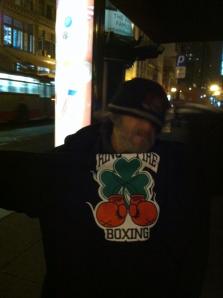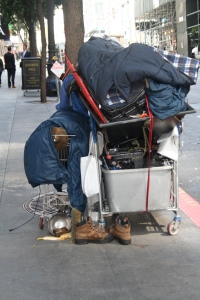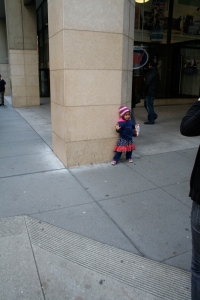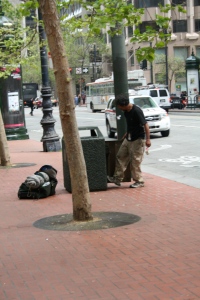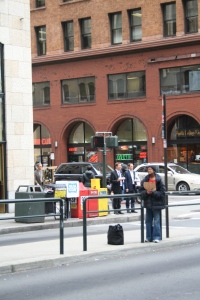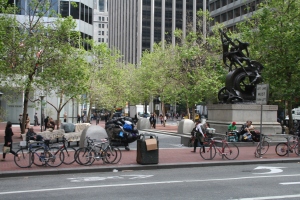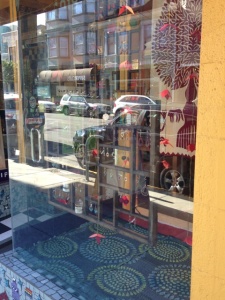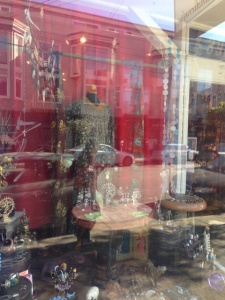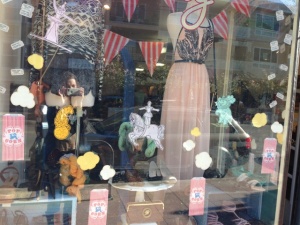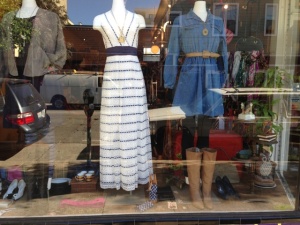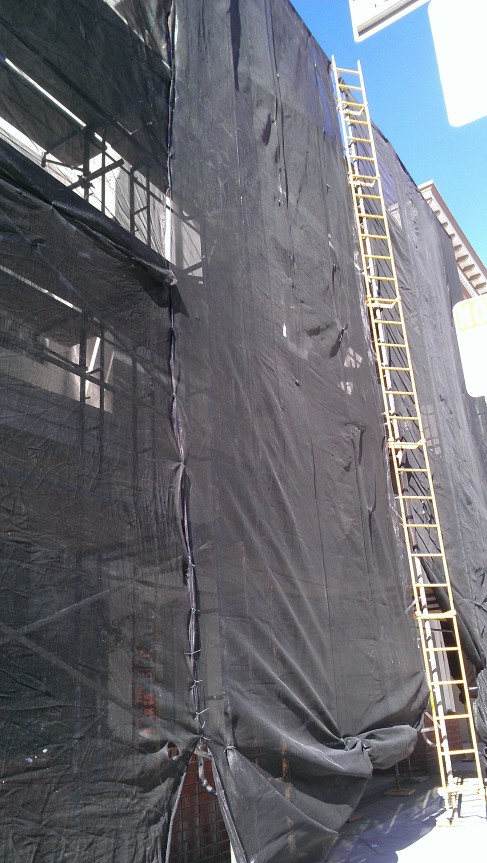The whiskey burns going down, as Karl poured Jack and I another round.
We exchanged stories in the empty pub as I shook with the thought the come 2:00 a.m. the uncomfortable bar stools at Murphy’s will no longer be for my use and until sunrise my only safe haven will be the alleys and doorways that are speckled with the steam of warm bodies pouring into the Financial District streets.
The California sunset paints a Technicolor dream to the backdrop of the Golden Gate Bridge each evening in San Francisco. Here, the skyline can be seen for miles all around, with the speckled canopy of lights that glow high above the bay. From chic designer boutiques and swanky jazz clubs, fifty stories up; to a round-the-clock nightlife and more restaurants than meals in a lifetime; San Francisco has it all.
San Francisco’s Financial District has been dubbed “Wall Street of the West” and as Northern California quickly becomes the seat of the technological revolution following Apple, Google and Facebook, the wealth continues to pour in.
Truly a spectacle, the term “working 9 to 5” is far less of a joke in the Financial District, and each weeknight with the sunset comes the mass exodus to the suburbs and San Francisco becomes a ghost town. Just blocks from Union Square, it is not uncommon to hear the sad music from an untraceable saxophone slowly drift through the air, as if carried by the fog. But all is not still.
The deepest bowels of the Financial District are the first stakes to be claimed. Camps are set up from door-to-door, down entire streets, filling alley ways, and seeping out from behind dumpsters. San Francisco’s poor and destitute claim the downtown area nightly, before 9:00 p.m.
Jack is scarred by his tour in Vietnam. He has a few war stories, all with no beginning, nor end, but are instead a glimpse of memories Jack was able to keep after his return and the following seventeen year heroin addiction that left him in poverty and poor health.
I used to bring Jack a sandwich every night. I have given him jackets, art supplies, cigarettes, and even a few bucks from time to time. But everyday, without fail, if I saw Jack, I brought him a sandwich. His favorite was the whole wheat BLT, partly because it was soft, and Jack only had a few teeth so that made sense.
When Jack left the service, he came back to The States with a developing heroin addiction, PTSD, and only 8 and a half fingers, give or take a knuckle.
When Jack tells me about his life, especially things that happened after he returned from Vietnam, the stories don’t really have a beginning, an end, or really even a premise. They are, for the most part, just blips and blurbs; broken pieces of memories that he has held onto. Piecing the story together based on information Jack gives me becomes my job, as is the puzzle of journalism.
Things looked up for Jack after, with a little help, he was able to subside his addiction to heroin. “I always figured,” he said, reminiscing about his redemption, “if I could go out every night to find a hit, then I could go out every night and find a piece of chocolate instead.” And so he did, and as Jack explains.
The last few times I’ve seen Jack, he is making a toy. He always offers to give them to me, but I always tell him I want him to perfect them first and that he can’t give me his old ones, because he has to use them to make his inventions better. He has offered to give me everything from candy, cigarettes, a beer, a sweatshirt, a pair of boxing gloves and a place to sleep for the night. I never intend on taking anything from him, but he often insists, so I oblige.
This has largely been my experience of being in, and reporting from the Financial District. In a city famous for its wealth disparity, the Financial District and Union Square show the violent opposition between the extremely wealthy and those living in extreme poverty. No where else in the city, or in most of the U.S. is this sharp contrast so easily seen. From my first moments on the scene, it was obviously the theme of this neighborhood, and everything I had written from then on portrayed that, largely at no fault of my own.
Cindy and Chris Smith moved to San Francisco from Riverside, and being from Riverside myself, this commonality gave me a connection with them, much like how I had with Jack. To this day I still see either Chris, Cindy, or both of them regularly.
I spent most of a night with them once when I was leaving Murphy’s pub very late, and saw them on my way home. I sat and had a cigarette and a beer with Chris, but Cindy seemed very much in pain. I asked Chris what was wrong, and that’s when I learned of Cindy’s congestive heart failure, and Chris told me about how he had to buy her medication illegally in the Tenderloin every night with the money they scrounged together panhandling that day. Of course, Chris still found a few bucks to buy a beer and a pack of cigarettes pretty regularly, so I knew his priorities weren’t always straight, but that never came as much of a surprise, despite my belief that somewhere in him, behind the addiction, the lying, and the jail tattoos, was a good person. I still choose to believe that.
That night I walked with Chris for a few hours, around the city, just talking. It was amazing to me, to see that when I was in circumstances where if I was alone, I surely would have been jumped, robbed, or both, but having Chris with me, and using his street smarts kept me safe, at least in a few occasions.
That night he told me about how at one point Cindy was a teacher in Los Angeles, after they got married in Las Vegas. Chris went to jail for a few years before getting out on parole. Chris did not really want to talk about the things that happened between the time he got out of jail and he and Cindy wound up on the streets of San Francisco, but my best guess was that the combination of his addiction and her health issues led to a downward spiral and somehow they wound up here.
Things are looking better for them too. Cindy has begun to receive SSI checks from the government because of her health condition, which amount to about $1300 a month. The Cable Car Hotel on California and Larkin, an SRO hotel, has agreed to take them in and they have big plans of slowly getting off the streets and getting their lives together again.
While in the Financial District, I am exposed to the same old cliché: wealth is not equivalent to happiness. And I can say that part of the time that is definitely true. I have seen happier faces on Jack when he makes a toy that whistles, or on Cindy when I have coffee with her in the morning, or on Chris when he shaves and gets a new pair of shoes and moves towards getting his life back together. I have seen happier faces in dark alleys than I see at the coffee shops early in the morning, or the cafés during lunch time because those smiles are forced and artificial. When someone who has nothing and suffers every day, finds the strength to pull a smile; that is true joy.
When I spent the night with Jack, or the night with Cindy and Chris, I was scared, but I always had that option of going back home in my head. In the back of my mind I always knew that there was a safe place open to me at all times.
At the latest parts of the night, it’s not hard to believe stories of robberies, like I saw during writing my crime story. Incidents like Chris getting robbed after getting his teeth kicked in become all the more real when shady figures lurk around every corner. The echo of schizophrenic screams bellows through the buildings. Closer to Market Street, once an hour there seems to be some sort of confrontation that lasts about fifteen minutes.
More south on Market, past Powell, is where the drug dealers hang out. Interestingly though, they don’t usually walk all the way up to the Financial District. Because of this it seems, that the people who choose to live in the Financial District, rather than the Mission, Hunters Point, or the Tenderloin, tend to be older, or have severe mental or physical health problems that leave them vulnerable. Although the Financial District may be safer than other places in San Francisco with high concentrations of homelessness, it doesn’t make the stories heard here any less sad.
Stories of homelessness cannot be told without considering addiction. But where most people fail to understand is when they attribute homelessness and addiction to personal choice. The rationale is that someone has to make a personal choice at some point to take a drink, or a hit, and therefore their addiction is a personal choice, and that’s what makes them homeless. The reality of the situation is that no one chooses to be homeless, the fact is no one is given a choice.
And as the early morning sun begins to shine a light on only the highest building tops, the streets at the bottom of the concrete canyons slowly become awake and begin to pulse with movement and noise. The desolation of those in need is pushed to the curbs, to hold out an open hat and beg at the mercy of the much more fortunate. The sound of taxis, busses, cars and cellphones sing in a cappella as the sidewalks slowly fill with the smell of freshly brewed Starbucks and nine-to-fivers, and slowly empty the lost souls of a broken city back into the darkness where most of us never care to look. San Francisco’s Financial district has awoken.

